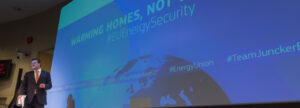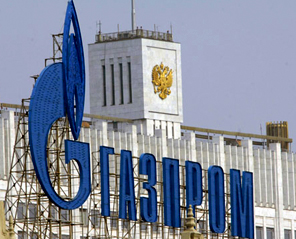EU Insists Energy Security Is About More than Gas
- News
- 17 February 2016
- by Energy Post
Article published on Energy Post
 “When it comes to energy security in the long term, there is no better antidote than focusing on sustainable energy,” said EU Climate and Energy Commissioner Miguel Arias Cañete at the launch of a new EU energy security master plan in Brussels on 16 February. The Commission defended its proposals – which focus on safeguarding gas supplies – as an aid to moving Europe along to a low-carbon economy as well as preparing it for possible supply disruptions. But despite the rhetoric, the legislative punch was in how to get more gas, not use less of it. Sonja van Renssen reports.
“When it comes to energy security in the long term, there is no better antidote than focusing on sustainable energy,” said EU Climate and Energy Commissioner Miguel Arias Cañete at the launch of a new EU energy security master plan in Brussels on 16 February. The Commission defended its proposals – which focus on safeguarding gas supplies – as an aid to moving Europe along to a low-carbon economy as well as preparing it for possible supply disruptions. But despite the rhetoric, the legislative punch was in how to get more gas, not use less of it. Sonja van Renssen reports.
The European Commission framed its new proposals on 16 February as an “energy security” package, not a “gas” package, although many have been calling it that. “Today’s package is not only about security of supply,” said the Commission’s Vice President for Energy Union, Maroš Šefčovič. “It’s also about the efficiency of our energy consumption.” He cited in particular the launch of a first-ever dedicated plan for the heating and cooling sector in Europe, to “address what we can do more of to consume less”.
“Our strategy is not about using more gas, but about using it more intelligently.” – Miguel Arias Cañete, EU Climate and Energy Commissioner
On 16 February, the Commission published four new initiatives. Two legislative proposals give Brussels more oversight on gas deals with foreign countries and suppliers, and usher in a regional approach to energy security. They revise a 2012 EU law that created an information exchange mechanism for intergovernmental agreements (IGAs) on energy with non-EU countries (e.g. Russia) and a 2010 regulation on security of gas supply, respectively. Two non-legislative strategies meanwhile, are there to improve access to and use of LNG and gas storage, and to decarbonise the still for three-quarters fossil fuel-dependent heating and cooling sector in Europe. (Read this Energy Post analysis of the gas supply aspects of the proposals based on leaked drafts that remains largely accurate. We also explained what is at stake.)
“Our strategy is not about using more gas, but about using it more intelligently,” argued Miguel Arias Cañete, EU Climate and Energy Commissioner on 16 February. “Energy efficiency has to be prioritised if we are to improve our energy security and make good on our Paris [COP21] commitments.” He reminded journalists that every 1% increase in energy efficiency delivers a 2.6% drop in gas imports. He concluded: “Being ambitious on energy efficiency policy is the central plank of our long-term energy security strategy.”
Red carpet for Gazprom
 That’s not how NGOs and Green MEPs interpreted the package on Tuesday. For them, the Commission is proposing an unrealistic and unnecessary reliance on gas going forward. “It’s like the Paris agreement never happened,” said Jiri Jerabek, energy policy advisor at Greenpeace EU. Molly Walsh from Friends of the Earth Europe lamented: “The energy security package locks Europe into decades of fossil fuel use.” For Green MEP Claude Turmes, the proposals amounted to “rolling out the red carpet for Gazprom”.
That’s not how NGOs and Green MEPs interpreted the package on Tuesday. For them, the Commission is proposing an unrealistic and unnecessary reliance on gas going forward. “It’s like the Paris agreement never happened,” said Jiri Jerabek, energy policy advisor at Greenpeace EU. Molly Walsh from Friends of the Earth Europe lamented: “The energy security package locks Europe into decades of fossil fuel use.” For Green MEP Claude Turmes, the proposals amounted to “rolling out the red carpet for Gazprom”.
The question that divides stakeholders is how much gas Europe will use in future. And related to that, what role do policymakers want gas to play in the low-carbon economy? On 16 February, Cañete shed some light on the Commission’s thinking. “Gas can be the bridge between coal and renewables,” he said.
The Commission has persistently overestimated gas demand… and needs to restore the credibility of the forecasts it uses.” – European Court of Auditors
“We have a very precise estimate of how much gas Europe will need in 2030,” Šefčovič told reporters. “We would expect that in 2030 we would need 380-450 bcm [billion cubic metres]. That’s based on ten different modelling exercises after factoring in all the efforts on renewables, energy efficiency and in reducing greenhouse gas emissions by 40%.”
But critics point out that the Commission has a history of getting it wrong. They cite a recent report by the European Court of Auditors which concludes as much: “The Commission has persistently overestimated gas demand… and needs to restore the credibility of the forecasts it uses.” They looked at biannual forecasts from 2003-2013. Where the auditors and Commission agree is that gas demand is unlikely to increase from the roughly 400 bcm a year today. What the critics argue is that stronger renewables and energy efficiency policies not “may” – as the Commission says – but “will” reduce gas use in future. Gas use in Europe in 2013 was at its lowest level since 2000.
The Commission is currently modelling scenarios with energy efficiency goals of not just 27% in 2030 – as agreed by European leaders in October 2014 – but also 30% (suggested by the Commission) and 40% (repeatedly requested by the European Parliament), said Cañete on 16 February. This is in the run-up to a review of the EU’s 2012 energy efficiency directive later this year. Committing Europe to a 40% energy efficiency goal would presumably require a recalculation of gas demand.
Heating and cooling party
Turmes finds “nothing” in the energy security package “on improving energy efficiency and promoting renewables in the transport sector or in heating and cooling systems”. Not everyone was quite so gloomy. Notes of approval – or was it relief? – came from the heating and cooling sector at finally having a dedicated EU strategy. “Congratulations to the Commission for the amount of work that was put into this strategy,” said the European Heat Pump Association (EHPA). “The wording of the document fits Europe’s ambition to be leading in renewables.”
Euroheat & Power hailed the strategy as “indisputable recognition” of the role of the heating and cooling sector in the transition to a low-carbon economy.
“The whole perception of heating has changed in the Commission over the last few years.” – David Connolly, Associate Professor at Aalborg University and coordinator for the Heat Roadmap Europe project
The Heat Roadmap Europe project, led by the Sustainable Energy Planning Research Group at Aalborg University in Denmark, applauded the Commission for having “warmed considerably” to district heating. “The whole perception of heating has changed in the Commission over the last few years,” said David Connolly, Associate Professor at Aalborg University and project coordinator. He believes that district heating could quadruple its share to almost half of all heat supply in future. It could drive vast energy efficiency improvements by harnessing waste heat from power plants, large industries and waste incinerators as well as drawing on heat pumps, solar thermal and geothermal power.
In contrast, gas advocates were more lukewarm in their reception of the heating and cooling strategy. GasNaturally, representing the European gas industry, welcomed “the Commission’s focus on the role of gas in the Energy Union” but said it had “missed an opportunity by not fully recognising the role that gas can play in heating”. The group pointed to the potential of “high-efficiency, gas-based and hybrid heating options” to cut consumption by 20-50%. It also suggested that gas can be renewable thanks to biogas, and pointed out that renewable electricity can be transformed into hydrogen and gas for handy transport and storage.
“It’s encouraging to see that the Commission recognises the strategic importance of gas,” said Roland Festor, EU Affairs Director at the International Association of Oil & Gas Producers (IOGP). “[But] the Commission should clarify the apparent contradiction between efforts to use more electricity and less gas in heating (even though gas is cheaper and more efficient), and a goal of promoting investment in gas.”
Down to action
The fact remains that for all the Commission’s kind words about energy efficiency, the 16 February energy security package was first and foremost about gas. There is logic to this: “For the tenth consecutive year, the EU needed to import over half the energy consumed in 2014,” said Cañete. The EU depended on imports for about two-thirds of its gas in 2013, and 39% of those came from Russia. Regardless of what happens to overall gas consumption, the proportion of it that is imported will need to counterbalance a persistent decrease in domestic gas production after a peak in 2000.
“We will develop renewables and energy efficiency, and we will reduce our emissions regardless of the price of oil.” – Miguel Arias Cañete, EU Climate and Energy Commissioner
A growing dependence on imports presents a risk to gas security of supply. It is why the Commission makes important proposals to, for example, increase solidarity between member states (e.g. vulnerable customers in neighbouring countries should be prioritised over non-vulnerable customers at home in case of a supply disruption); to better assess the potential impact of supply disruptions (e.g. the Commission wants to be able to request more information about commercial supply contracts if these last for more than a year and give a supplier at least a 40% market share in a country); and to prioritise infrastructure that will ensure every member state access to LNG (even if LNG terminals are only used at 20% capacity on average at the moment).
That said, the scope for gas in the EU energy mix is limited – at least without carbon capture and storage (CCS) – if Europe is serious about an 80-95% greenhouse gas emission reduction by 2050. A new chapter on sustainability in the Commission’s LNG strategy warns against “technology lock-in or stranded assets”. Europe’s long term direction of travel is clear, said Cañete on 16 February: “We have agreed in Paris to commit ourselves to a transition to clean energies. We will develop renewables and energy efficiency, and we will reduce our emissions regardless of the price of oil.” New EU directives on energy efficiency, renewables and the energy performance of buildings later this year will have to bear that promise out.
Latest News
-

-
 26.10.2021 Celsius Summit 2021 – Energy Democracy
26.10.2021 Celsius Summit 2021 – Energy Democracy

